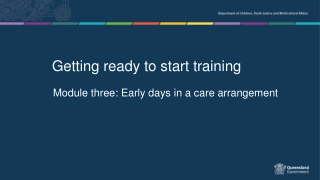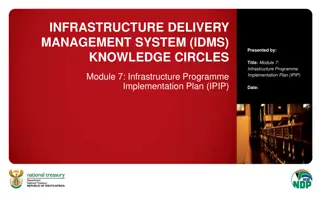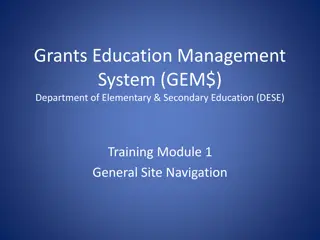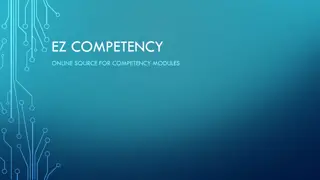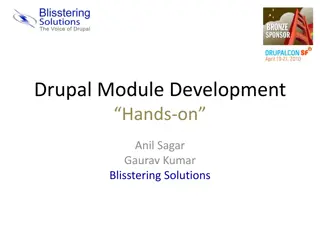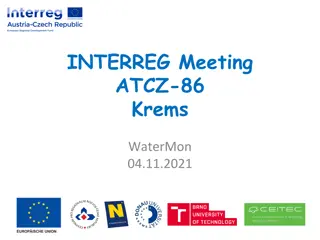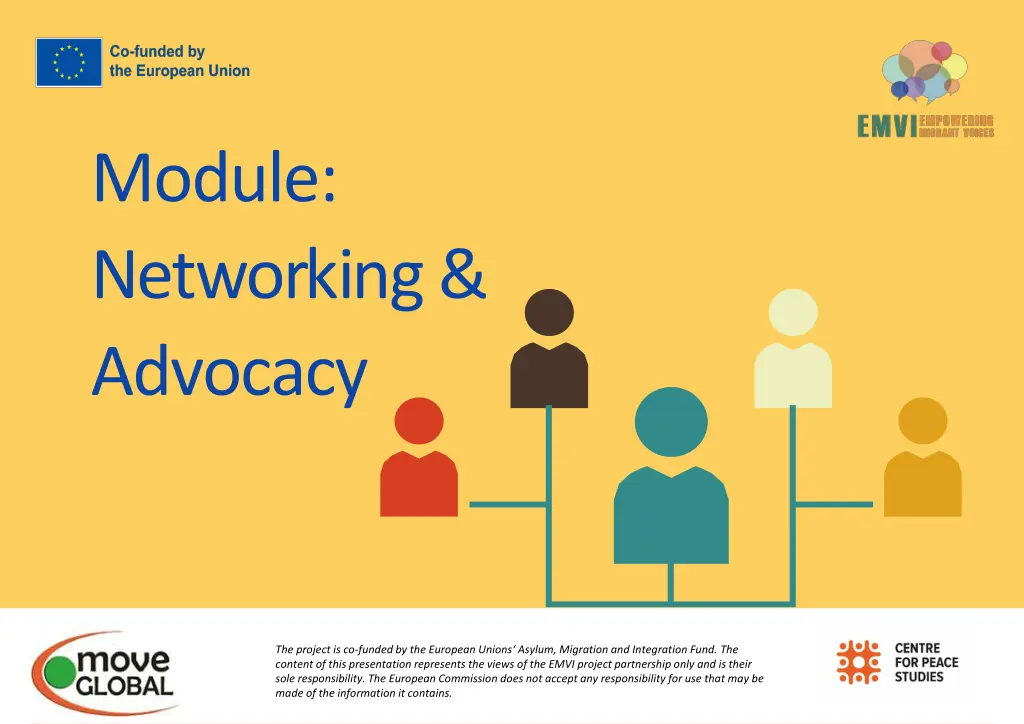
Strategic Networking & Advocacy for Effective Engagement
Explore the significance of strategic networking and advocacy in the realm of asylum, migration, and integration. Learn how to identify relevant networks, engage in stakeholder analysis, and develop action strategies. Discover the importance of joint cooperation, knowledge exchange, and maintaining organizational values while navigating diverse networks.
Download Presentation

Please find below an Image/Link to download the presentation.
The content on the website is provided AS IS for your information and personal use only. It may not be sold, licensed, or shared on other websites without obtaining consent from the author. If you encounter any issues during the download, it is possible that the publisher has removed the file from their server.
You are allowed to download the files provided on this website for personal or commercial use, subject to the condition that they are used lawfully. All files are the property of their respective owners.
The content on the website is provided AS IS for your information and personal use only. It may not be sold, licensed, or shared on other websites without obtaining consent from the author.
E N D
Presentation Transcript
Module: Networking & Advocacy The project is co-funded by the European Unions Asylum, Migration and Integration Fund. The content of this presentation represents the views of the EMVI project partnership only and is their sole responsibility. The European Commission does not accept any responsibility for use that may be made of the information it contains.
GoalsofthisModule Achievinganunderstandingof strategicnetworking Learningtonetworkwithsmall resources Developing strategiesfor actionanda stakeholderanalysis IntroducingAdvocacy
Networking 1. WhyisNetworking Important? 2. WhatisaNetwork? 3. Identificationofrelevant Networks 4. StrategicPlanningof Networking
Why is networking important? 1. Joint cooperation and representation of interestsare alwaysstrongerthanby one actor 2. Exchangeofknowledge 3. Morecreativepowerand influence 4. Facilitationofwork(in thelong term, but beforethatthere is additionalwork,so don'ttakeon toomuch atfirst,especially becausemanymigrant organisationsare dependenton voluntary work 5. Ifyou workintherightnetworks,you can get information more quickly, influence decisionsand workoutand implement strategiesforthe developmentofyour organisation more effectively 6. Perception asasuccessfuland attractiveorganisation 7. Quicklyidentifyingnew developmentsand developing appropriate services Source:Strategische Planungerfolgreicher Netzwerkarbeit- Ein Leitfaden f rMigrantenorganisationen,Herausgeber:DerParit tischeGesamtverband,1 .Auflage2011, https://www.house-of-resources.berlin/wp-content/uploads/2017/06/A4_MSO-netzwerkarbeit_web.pdf
Theadditionalworkloadof networking shouldbe discussedinthecontextofthe organisation Values&identityoftheown associationshould bepreserved, despiteactivitiesindifferent networks What are the challenges? Networkingcanonlyhavethedesired effect if you have access to the most influential networkstoachieveyour aims.Thisrequiresan in-depth analysisofyourgoals,resourcesand relevantstakeholders Source:StrategischePlanungerfolgreicher Netzwerkarbeit-Ein Leitfadenf rMigrantenorganisationen, Herausgeber:DerParit tischeGesamtverband,1.Auflage2011 https://www.house-of-resources.berlin/wp- content/uploads/2017/06/A4_MSO-netzwerkarbeit_web.pdf
What are networks? "ANETWORKDIFFERSFUNDAMENTALLY FROM AN ORGANISATIONIN THE PRINCIPLEOFCONTROL: INSTEADOFA CONTROLCENTRE,SOCIAL NETWORKS HAVEALARGENUMBEROFNODES THAT USETHERECIPROCALRELATIONSHIPSIN GREATAUTONOMY." Herenetworksaresymbolsforthelinkbetween people. Theelementsofsocialnetworkscanbeindividualsas wellasgroupsor organisations Socialnetworkshave: Commoninterestsandintentionsofactors Personalorientation Voluntaryparticipation Relationshipsbasedontheprincipleof exchangeand mutualtrust Amultitudeofnodesthatautonomouslyusereciprocal relationships GIVEEXAMPLES OF COUNTRYAND REGIONAL- SPECIFIC NETWORKS Source:StrategischePlanungerfolgreicherNetzwerkarbeit-EinLeitfaden f rMigrantenorganisationen, Herausgeber:DerParit tischeGesamtverband, 1.Auflage2011 https://www.house-of-resources.berlin/wp-content/uploads/2017/06/A4_MSO-netzwerkarbeit_web.pdf
Definition of Relevant Stakeholders (Stakeholder Analysis) Stakeholder analysis is a methodical instrument of strategic management.It involves: identification of influential interest groups from the environment of an organisation mapping in terms of their interests and influence strategic options for action are then to be derived from this picture "When building local networks, existing structures must be taken into account. The actors in the local areahaveknown eachotherwellforalongtime,also personally.Thesituationis characterised by established relationships of trust, often unspoken distributionoftasksandmulti-layeredworking relationships." StakeholderAnalysis= findingsuitableand appropriatepartnersforanetwork In the stakeholder analysis, the interest groups relevant to the organisation should be identified and presented in terms of their influence(power)andinterests. Source:Strategische Planung erfolgreicher Netzwerkarbeit- Ein Leitfaden f r Migrantenorganisationen, Herausgeber: DerParit tische Gesamtverband, 1. Auflage 2011 https://www.house-of-resources.berlin/wp- content/uploads/2017/06/A4_MSO- netzwerkarbeit_web.pdf Ifnecessary,theyareanalysed moreintensivelyfrom certain points of view (e.g. relevance, innovation potential,needfor communication, riskpotential).
Strategic Planning of Networking Themostimportant elementofsuccessful networking: sharpening theprofile andhaving goals clearlyinmind! 1 .. Setagoal: e.g. whatdoestheorganisationwant to achieveinthenextfewyears?Setannual goalstoachieve this. 2.Thedefinedobjectivesshouldcorrespond to the organisation's purpose as defined in the statute/mission,butshouldbe concretisedby concretecontent(e.g. projects).Theaim istoplanthe implementation of the organisation's purposes and objectives in order to make participationinnetworks efficient. 3.Now itisamatteroffindingthe appropriate resourcesandpartnersthatcan makethe achievementofthegoalspossible, andtoachievethis byworkinginnewaswell asexisting networks. Source:Strategische Planung erfolgreicher Netzwerkarbeit-EinLeitfaden f r Migrantenorganisationen, Herausgeber:DerParit tischeGesamtverband, 1. Auflage 2011 https://www.house-of-resources.berlin/wp-content/uploads/2017/06/A4_MSO- netzwerkarbeit_web.pdf
Strategic Planning of Networking (2) Thenextstep intheassessmentisthe developmentofstrategiesforaction. This entails: Identifying the status of the relationship between key contacts to be able toplanfurthersteps. Mapping the contacts with regard to the status of between the contact and our organisation, startingwiththecontacts the relationship Actionplanningtoreachpeople: 1.Ifnorelationshipexistsyet Approachcontactpointsviaathirdpartyordirectly(focusonproject+ownstrengths),cooperationpartnermustbe convinced the cooperation is beneficial for both sides. Keep in regular contact and inform about current developments. 2. Iftherelationshipalreadyexists Provideup-to-dateinformation.Exchangeinnetworkmeetings(workinggroups) Source:Strategische Planung erfolgreicher Netzwerkarbeit- Ein Leitfaden f r Migrantenorganisationen, Herausgeber:DerParit tische Gesamtverband,1.Auflage 2011 https://www.house-of- resources.berlin/wp- content/uploads/2017/06/A4_M SO-netzwerkarbeit_web.pdf 3. Peoplewithwhom onealreadycooperates Contactsare always important asareferencetogettoknowotherimportantpeople. Maintain contactregularly
Strategic Planning of Networking (3) Evaluation of success: Were all the goals that were tobeachievedwiththecooperationfulfilled? STEPSFORTHEEVALUATI ON: Concerning the partners: Have we contacted the right people? Which ones are still missing? How can we reach them? In which committeesshouldweparticipate additionally? Withregardtothegoal:Istheachievementofthe goalrealisticintermsofcostsandbenefits?Isa reorientationnecessary? Inrelationtoyourownorganisation:Have weusedourstrengthsenough?Havewe reduced our weaknesses? Source:StrategischePlanung erfolgreicher Netzwerkarbeit-EinLeitfadenf rMigrantenorganisation Herausgeber: DerParit tischeGesamtverband,1.Auflage2011 https://www.house-of-resources.berlin/wp-content/uploads/2017/06/A4_MSO-netzwerkarbeit_web.p
EXCURSUS: ADVOCACY 1.Whydoorganisationsdoadvocacy? 2.Howtoadvocate successfully? 3.Howtocommunicate?(RhetoricalSkills)
Advocacy... Short intro exercise with group: discuss the definitions and understandings of advocacy. gather examples of successful advocacy campaigns from your group and discuss what was good, what changes happened due to the advocacy efforts Advocacy is a strategy to influence decision-makers for them to change the way they decide on a specific issue.
Why do organisations do advocacy? Advocating is one of the most effective ways to implement changepolitically. By demanding new rules of the game, civil society actors can address the causesof the great challenges of our time, notjusttheirsymptoms. It is true that migrant and civil society organisations in general have fewer resources for their advocacy work compared to private corporations. But (according to Prof. Alberto Alemanno) more resources do notequatetomoreinfluence. social Source:The European guide to citizen lobbying, Brussels 2019 https://www.thegoodlobby.eu/wp-content/uploads/2019/07/Toolkit-EU.pdf
How to advocate successfully? (1) PolicyCycle The list of possible matters is very difference between advocating on issues that were discussed by decision makers, and thosethatwerenot! long, but there is a big already It is important to stay informed and to know what happens in the political environmentofyourfieldofwork. It is also important to choose the right moment to advocate for your goals that you want to be included in a policy or law etc. The ability to impact a specific issue will depend on the stage of the issue in the policy cycle. E.G.: Most interesting stages can be from the stage of idea to proposal and from proposal to adoption. In implementation stage, only implementation might be influenced - not the matter itself Source:The European guide to citizen lobbying, Brussels 2019 https://www.thegoodlobby.eu/wp-content/uploads/2019/07/Toolkit-EU.pdf
Theseonlinemedia outletscan alsobeuseful forEUadvocacy:Politico, TheHillorEuroactiv How to advocate successfully (2) Remember: The sooner you become involved, the morescopeyouhaveforyourimpactina matter! Differentcountries and administrations publish the legislativeinitiativesthroughtheir officialwebsites. Forexample: https://eur- lex.europa.eu/homepage.html? locale=en https://www.europarl.europa.eu/legislative- train/ INCLUDE COUNTRY+REGIONAL SPECIFICS Forexample:whenaregulatoryproposalisalreadydrafted, it will be difficult to change it. But if you are able to campaign to changethat proposalasitmovesthrough the legislativeprocess, yourimpactcould be taken intoaccount. Source:The European guide to citizen lobbying, Brussels 2019 https://www.thegoodlobby.eu/wp- content/uploads/2019/07/Toolkit- EU.pd
Stakeholder Mapping Stakeholdermappinghelpsyoubetter understandwho canbeyouralliesandwho stands inyourway.Thatis whyitisakeystrategyforsuccessfulnetworkingaswellasadvocacy work.Italso helpsyoutoform coalitions! 4 important groups: policymakersandrepresentatives:thisshouldbe yourmain focusastheyhavethepowerto implement/change policies/laws; allies:NGOs,mgrant organisations, like-minded organisationsand expertswhocansharetheir resourcesandknowledge; opponents:actorswhodisagreewithyouandmay be against your interests; influencers:non-expertpeoplewhohavethepower to influence the public opinion and your targeted groups in a formalorin-formalway Source:The European guide to citizen lobbying, Brussels 2019 https://www.thegoodlobby.eu/wp- content/uploads/2019/07/Toolkit-EU.pdf
10 Steps in Advocacy Planning* Identify the problem Set the goal & objectives Map the arguments Gather friends! What Design the action plan Who are your allies? Identify your targets resources are needed? Implement, monitor, evaluate Celebrate successes! Source: Training Kit for Empowering Refugee-Led Community Organisations, 2022, https://aditus.org.mt/our-work/projects/training-kit-for-empowering-refugee-led- community-organisations/
10 Steps in Advocacy Planning o Look for people who share your concerns. o Are there existing groups or networks coveringyour goals? Gather friends! o Engagewiththemin meetings. o Ajoint agenda wouldbegreat. o Think simplyone-offcooperation. long-term partnerships, not
10 Steps in Advocacy Planning o Think of the actual problem(s) faced: not the main issue, the real problems! o What is thecause of the problem? Identify the problem o Try to identify the structural issue: a law, policy or rule. o What are the concrete effects of the problem?
10 Steps in Advocacy Planning o GOAL:Thechangeyou want tosee. o Focus onan end, not a meansora tool. Set the goal & objectives o Makesureit isclearto all. o OBJECTIVES: What is needed for the changetohappen? o BeSMART!
What is a SMART objective? Specific Time-based Measurable Relevant Achievable
What is a SMART objective? Smart Measurable Achievable Relevant Time-based Well- defined (who, what...) How will you recognise success? Is it Have a time-frame actually possible? To the Goal Are you able to observe progress? Resources? Timing? Capacity? Helps achieve the goal Sufficient but not excessive Clear
10 Steps in Advocacy Planning o Research: gather thefacts! o Who is affected? Particular groups? Map the arguments o Anyexisting research? o Official data & statistics? o Document it!
Identify your targets Who has the power? Possible multiple decisions or decision-makers Tailor the strategy Understand the context
10 Steps in Advocacy Planning o How about a coalition? o Who can endorse, support? Who are your allies? o Who are your opponents? o Ensure clarity + agreement on the goal and objectives! o Respect differences!
What resources are needed? What do you have? (skills, tools, funds...) What is reasonable needed for yours goals and objectives? How are you going to get there?
Design the action plan Public education Direct Meetings Government officials Go ahead & be creative! Campaigns Letters Articles Partners Petitions Reports Refugees Phone calls Events Media
Implement, monitor, evaluate What is the activity? Who is responsible for it? What is our Plan B? How to we measure performance? What resources are needed?
10 Steps in Advocacy Planning o Monitoring is a regular collection of info and data to measure changes overa period of time. Monitoring & evaluation o Evaluation looks at the direction of an activity and makes a judgement on progress and impact. o What has changed? What were our aims?What havewe(not)achieved?
Celebrate successes! Boosts morale Shares good practice Strengthens accountability Lessons learnt
o Identify a challenge/ problem your organisation / you have been trying to influenceand change Exercise o Use the 10 Steps in Advocacy Planning to create strategy! your own o Listen and respect each other!
How to communicate (1) Communicating advocacy actions means communicating information and winning the attention of at least 3 different target groups: Decision-Makers Media Public Opinion Use different tools and mix them up to achieve your own goals: Traditional media: opinion articles, interviews, letters, quotes Digital media: blogs, personal websites, social networks and events: press conferences, workshops, seminars, sit- ins, hackathons Distribution of instructive material: infographics, brochures, gadgets publication of formal acts: petitions and complaints HOWEVER SOMETIMES ONE CAN BE ENOUGH. Source: TheEuropeanguidetocitizen lobbying, Brussels 2019 https://www.thegoodlobby.eu/wp- content/uploads/2019/07/Toolkit-EU.pdf
How to communicate (2) Source:The European guide to citizen lobbying, Brussels 2019 https://www.thegoodlobby.eu/wp- content/uploads/2019/07/Toolkit-EU.pdf
How to communicate (3) SpokenAdvocacy(RhetoricalSkills) Ethos-Thespeaker spowertoenhancetheir personal characterandcredibility. Appearlikeableandprofessional; come prepared; clearandconcisedelivery Pathos-Thespeaker spowertostiremotionof theaudience. Tellacoherentandconsistentstory; highlightthemostimportantandcompelling facts. Logos-Thespeaker spowertoprovetheir argument. Carefullystructureyourargument; select yourkeyissues; developacoherenttheme Source:The European guide to citizen lobbying, Brussels 2019 https://www.thegoodlobby.eu/wp- content/uploads/2019/07/Toolkit-EU.pdf
Self-advocacy Self-advocacy is being able to speak up for yourself and being able to ask for the things that are important to you. Self-advocating is saying what you think and asking for what you want and need, this is because you know you best and people need to listen to you if you are not happy or you want something to change (source and more info on self-advocacy: https://www.rethinkessexadvocacy.org/media/to0h313r/taking-control-a- guide-to-self-advocacy.pdf) Useful toolkit on self-advocacy that focuses on three steps that can help us to improve the way we communicate while we self-advocate: knowledge, skills and confidence. Read up more and use the toolkit in your trainings! https://advocacyfocus.org.uk/wp- content/uploads/2022/04/The_Essential_Self_Advocacy_Toolkit_1119.pdf
Links for Further Reading Add national and local Links! https://www.thegoodlobby.eu/wp-content/uploads/2019/07/Toolkit-EU.pdf https://www.transparency.de/fileadmin/Redaktion/Publikationen/2014/Lobb ying_in_Germany_TransparencyDeutschland_2014_EN.pdf


